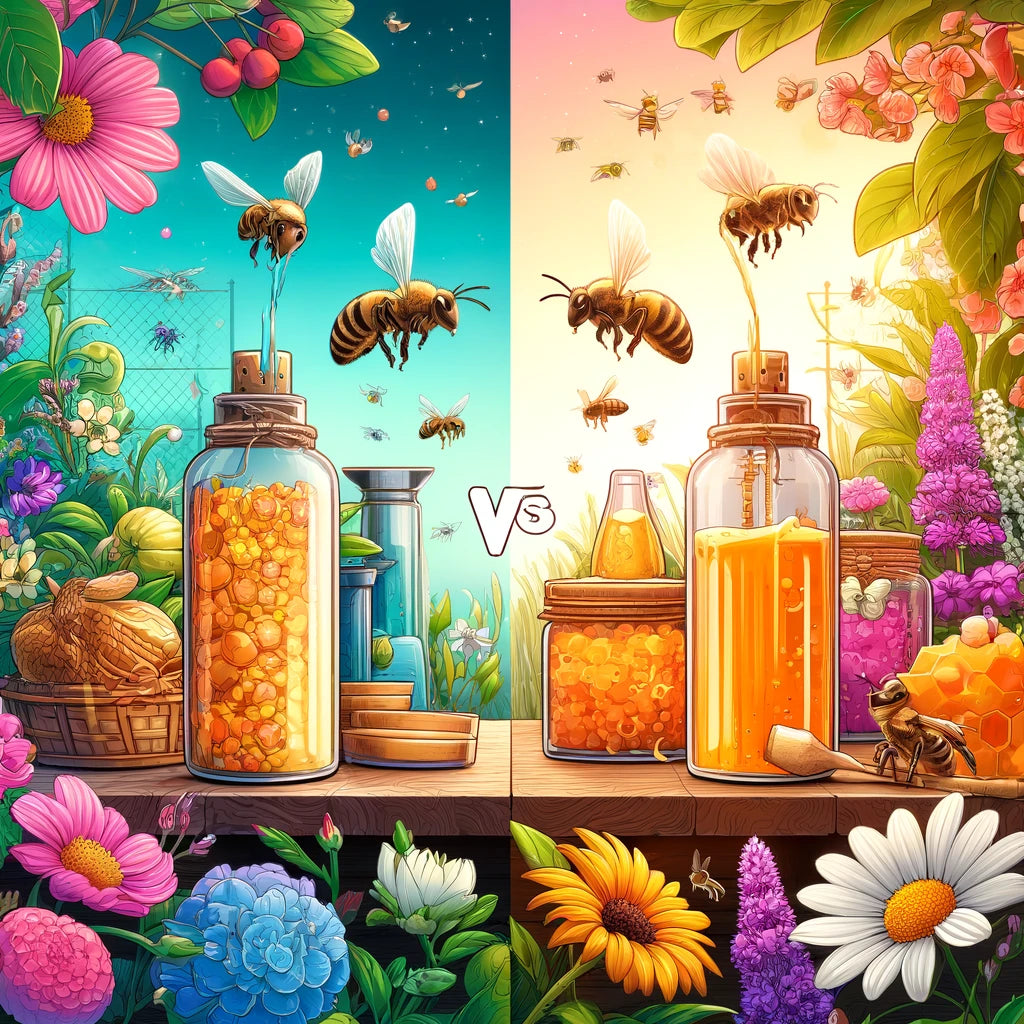Beekeeping and garden maintenance often involve managing bee populations to ensure safety and productivity. One effective method is bee traps, which require attractants to lure bees effectively. The choice between natural and synthetic bee trap attractants is crucial, depending on various factors, including effectiveness, safety, and environmental impact.
This article delves into the pros and cons of natural and synthetic bee trap attractants, helping you decide which is best for your needs.
What are Bee Trap Attractants?
Bee trap attractants, or baits, are essential tools used to lure bees into traps by replicating the scents and pheromones that are naturally appealing to them. These attractants fall into two primary categories: natural and synthetic.
Natural attractants include lemongrass oil, geraniol and food-based scents like honey and sugar water, prized for their minimal environmental impact and safety. On the other hand, synthetic attractants are engineered to closely mimic the natural pheromones of bees, offering high potency and consistency across applications.
Natural Attractants
Natural attractants are a favored choice for beekeepers and gardeners looking to lure bees into traps or hives due to their environmentally friendly and safe characteristics.
Common Natural Attractants
- Lemongrass Oil: Mimics the pheromones produced by queen bees, making it highly effective in attracting scout bees.
- Geraniol: An alcohol-based compound found in geraniums that serves as a powerful bee attractant.
- Honey and Sugar Water: Simple yet effective, these sweet solutions attract bees looking for a quick energy source.
Pros
- Eco-Friendly: Natural attractants are biodegradable and do not contribute to environmental pollution.
- Non-toxic: They are safer for children, pets, and other wildlife, minimizing the risk of adverse reactions.
- Selective Attraction: Primarily attracts target species, reducing the capture of non-target insects.
Cons
- Inconsistency: The effectiveness of natural attractants can vary widely depending on their source, preparation, and environmental conditions.
- Shorter Range: Natural scents may not attract bees from as far as synthetic attractants, potentially limiting their effectiveness in open or larger areas.
- Frequent Reapplication Needed: These attractants often evaporate or degrade more quickly, requiring regular replenishment to maintain effectiveness.
Synthetic Attractants
Synthetic attractants are scientifically engineered to closely mimic the natural pheromones of bees, providing a highly effective method for luring bees into traps or towards new hives. These attractants are particularly potent, can cover a broader range, and offer more consistent results than their natural counterparts.
Key Features of Synthetic Attractants
- High Potency: They are designed to be extremely attractive to bees, pulling them from greater distances than most natural attractants can.
- Consistency: Manufactured under controlled conditions, synthetic attractants ensure uniform quality and effectiveness, providing reliable results in various environmental conditions.
- Longevity: These attractants typically last longer once applied, reducing the need for frequent reapplications.
Products from Swarm Commander are popular among beekeepers for their proven efficacy and ease of use, making them a go-to choice for efficiently attracting bees despite the potential drawbacks.
Choosing the Right Attractant for Your Needs
Choosing the right bee trap attractant depends on several factors, including your specific goals, environmental considerations, and the practicalities of application. Here's how to decide between natural and synthetic attractants based on various scenarios:
Consider Your Goals
If your primary goal is to attract as many bees as possible, synthetic attractants like Swarm Commander may be the best choice due to their high potency and long-lasting effect. Natural attractants may be preferable for those looking to attract only certain types of bees or minimize impact on non-target species as they tend to be more selective.
Assess Environmental Impact
In areas where environmental conservation is a priority, such as near organic farms or protected wildlife areas, natural attractants are ideal due to their biodegradable and non-toxic nature.
Synthetic attractants might be more practical in non-sensitive areas where their broader range and effectiveness can efficiently manage bee populations without significant ecological disruption.
Practical Considerations
Consider how often you can reapply the attractant. If frequent reapplication is challenging, the longer-lasting synthetic attractants might be more convenient. Check local wildlife and chemical use regulations to ensure that your choice of attractant complies with local laws, particularly when using synthetic products.
By carefully weighing these considerations, you can select an attractant that meets your bee management needs and fits within your ethical and environmental framework. Whether you choose natural or synthetic, the right attractant will effectively help manage bee populations while aligning with your overall beekeeping or gardening strategies.
Final Thoughts
By weighing the pros and cons of natural versus synthetic bee trap attractants, you can choose the best option for your situation. Whether you opt for the gentle approach of natural attractants or the potent allure of synthetic options, the right choice can help you manage bee populations effectively while minimizing environmental and non-target species' impact.
Frequently Asked Questions About Bee Trap Attractants
Q: Can I make my bee trap attractant?
A: Yes, homemade attractants like sugar water mixed with vanilla or mint can be effective, though they may not match the potency or longevity of commercial products.
Q: How often should I replace the attractant in my bee trap?
A: Natural attractants typically need to be replaced every few days, while synthetic attractants can last several weeks or even months, depending on the product.
Q: Are there any attractants that are specifically harmful to bees?
A: Synthetic attractants should be used cautiously as some may contain ingredients harmful to bees or other beneficial insects. Always check the label and opt for products designed to be safe for bees.
Q: What is the most effective bee trap attractant?
A: The effectiveness can vary depending on the bee species and the local environment. Generally, products like Swarm Commander, which are designed to mimic bee pheromones, are highly effective.



